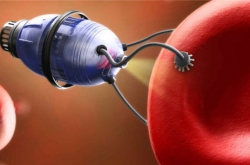How it all began
Gary Hix’s team began their research in the field of luminescence and anti-bacterial products in 2008 and 2011, respectively. Before that, the researchers focused on understanding the structure and synthesis of new materials, as well as the relations between them. Before moving on to luminescence, and, eventually, to biological activity, they conducted research on proton conductivity and catalysis. According to Prof. Hix, the initial interest towards luminescence grew out of an accidental conversation with another research group that worked on displays and technologies at the same university. At some point it led to a joint project with the company Filtrona (a subsidy of the well-known plastic and fiber product manufacturer Bunzl).

Luminescence
Luminescence is the non-thermal radiation of a substance that results from the absorption of energy. It was first described in the 18th century. Today, it sees a great deal of use in medicine. For example, you can apply the luminescence spectrum to assess the quality of products, their pharmaceutical properties, as well as to analyze tissue, skin, and more. The parameters of luminescent radiation can also tell us a lot about the condition of many types of tissue: nails, teeth, hair, eyes, and even help to discern between a malignant tumor and a benign one.
Materials need to exhibit a few specific qualities to be luminescent. In any case, luminescent materials absorb light before re-emitting it. This, too, depends on the composition of a material, and researchers are able to manipulate the wavelength of emissions by changing the composition.

One of the examples demonstrated by Gary Hix was the use of luminescent molecules in the creation of a microcrystal laser. In many cases, inorganic and organic components can synergize with each other, converting wavelengths from the UV spectrum into the visible or the IR spectra. The absorbed energy can be reproduced with a lower energy rate or transferred onto metal atoms. Changing the type of metal will have an effect, too: for instance, the element Europium will emit red light, while Terbium emits green light.
Anti-bacterial materials
The world today is facing the issue of bacterial resistance to pharmaceuticals. Strains of bacteria mutate and evolve to resist treatment, which leads to the use of increasingly more powerful drugs. In some cases, the bacteria evolve to be resistant to any treatment. The situation is worsened by the reckless and unnecessary use of antibiotics and other anti-bacterial drugs.

“In our work, we try to control these processes. Our main focus today is the use of silver as an anti-bacterial material. Silver is really good at killing bacteria, but it can also be toxic to the human body. What we need to do is use enough to combat bacteria, but not enough to kill a patient. By weaving silver into a MOF (metal-organic framework) we can manipulate the molecular structure and, therefore, control the material’s solubility as well as the speed with which the silver is discharged. We plan to consider other metals that exhibit toxicity towards specific bacteria,” explains Prof. Hix.
As mentioned above, the entire world is struggling with the issue of bacterial resistance. Developing new anti-bacterial products is one of the branches of a complex approach to solving this issue. Today, the research concerning MOFs is focused on a number of fields, such as drug delivery systems. Nevertheless, the production of pharmaceuticals (and pharmaceutical materials) can take a while to pass through the various regulatory procedures before they are prescribed to patients.

However, anti-bacterial MOFs can be used in other ways, too, such as in medical dressing materials. Other applications include the use of anti-bacterial drugs on surfaces to prevent the formation of biofilms, which are a common cause of infections in hospitals.
New materials for cancer and osteoporosis treatment
Osteoporosis is the result of imbalance between the growth of bone tissue and readsorption. Modern treatments often use phosphonic acids, which are capable of chemically merging with the surface of bone tissue and preventing the destruction of bone by osteoclasts. There is, however, a limitation: these acids are quick to dissolve in the stomach and pass through the digestive tract relatively quickly. As a result, only a small dose of a drug reaches the affected areas. Researchers from Crete have produced a number of materials that include the molecules of such drugs as part of a metal phosphonate (a type of MOF). A lower material discharge rate means that the material is slower to pass through the digestive system, sending more active material to the affected area.

Cancer treatment is much more complex than that, but metal phosphonates offer two potential treatment methods. The first concerns the creation of a drug delivery route to the infected area, as well as the sustained discharge of anti-cancer drugs. Since the drug is part of a phosphonate’s open structure, it is less likely to be discharged before arriving at the target area.
Another potential treatment method involves the creation of phosphonates based on the molecules of cancer treatment drugs. Several metal-based pharmaceutical products are currently in use in chemotherapy, and many organic molecules have shown a great level of cytotoxicity towards the various strains of cancer. Some reports include information about the synergetic effects of simultaneous use of various anti-cancer drugs. By combining these elements in a metal phosphonate, we unlock the potential to supply various synergetic active materials into cancer cells and, by manipulating their molecular structure, affect the rate at which the drugs are released into the system.





